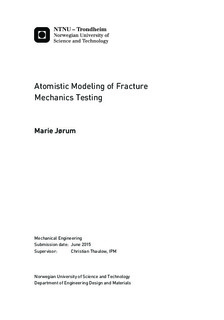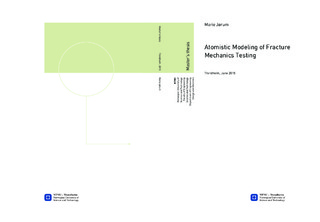| dc.description.abstract | Nanomechanical testing has become a well-acclaimed way of researching material properties. Today, with supercomputers and advanced programming codes for Molecular Dynamics (MD) available, there is also the possibility of creating computational models of nano-sized specimens, such as pillars and cantilevers. MD gives us an opportunity to go into the very depths of the material: the atoms, and explore the mechanisms in a way not achievable in a physical test specimen. As the oil and gas activity is increasing in the Arctic region, MD is becoming a viable tool for exploring materials under difficult circumstances, and see how they are affected by external factors such as very low temperature.
An atomistic model of a full-3D, nano-sized, pre-notched cantilever beam has been made. It has a simulated indenter force embedded, and MD simulations have been performed to deflect the beam and initiate crack growth. The crucial process zone in front of the crack has been investigated with respect to linear elastic fracture mechanics, elastic-plastic fracture mechanics and plastic deformation mechanisms such as dislocations and twinning. The effect of crystallographic orientation, crack geometry and loading rate has been studied. The stress intensity factor K has been calculated with three different approaches. In addition, the J-integral and energy release rate G have been computed.
The cantilevers proved to be highly affected by crystallographic orientation, displaying very different behavior from orientation to orientation. The loading rate did not appear to notably affect the fracture behavior, however, the two loading rates investigated are not highly different from each other, especially when compared to physical experiments. An even longer simulation would be exciting to examine, if time allows in future research. Two different crack geometries were also compared, one sharp and one round. The difference in crack geometry didn t affect the overall behavior of the crack growth as much, but in general, the sharp crack produced cleaner, more brittle crack growth.
The quantitative results showed that the K-calculations have expected results, based on previously obtained results. The energy release rate was obtained, and combined with the measured Crack Tip Opening Displacement (CTOD) used to find values for the yield stress, which fell within the expected range. The values acquired for J were compared with G, and found to be a bit high. Some refining of the method used to obtain J is probably needed for the values to be more precise on this level.
The atomistic model was compared to physical testing of a cantilever beam. The calculated K and J were lower for the modeled cantilever than for the physical ones, which was explained by the difference in loading rate, notch geometry, specimen size and material purity. | |

